We had a fun girls weekend planned to celebrate the birthday girls Daisy and Susie. Unfortunately the bad vacay vibes that have been destroying my plans (Singapore, Bali, Vietnam, Donghae) hit again. Half of the girls on the girls trip had to cancel so it was just the Daiser and I taking on the big city solo.
We had three main goals for this trip: purchasing a prom dress and shoes, purchasing souvenirs, and creating memories. We mostly failed with the first two items on the agenda, but we definitely scored on the last one.
Since it was a birthday trip, we decided to treat ourselves and fly there from Sacheon.
I have only been to Seoul a few times, and the last visit was over a year ago. There are almost 10 million people in the city (not including the suburbs, which house half of the entire country's population of 51 million containing 43,000 people per square mile), making it larger than New York City. I was able to get us everywhere that we intended, but we spent most of our time figuring out where we wanted to go.
A few times we apparently looked like poor lost tourists and kind people would ask if we needed help. The first time this happened was as soon as we exited the metro and were walking to our hotel. We would have eventually made it, but with a lot more walking than was necessary. That ended up being the theme for the weekend: a lot more walking than necessary, but we made it. Anyway, our first directions led us along Seoullo 7017. We visited this spot on our last girls' birthday trip to Seoul a couple years ago.
Seoullo 7017is a sky garden created from a former highway overpass. I love the way Korea upcycles the terrain.We had three main goals for this trip: purchasing a prom dress and shoes, purchasing souvenirs, and creating memories. We mostly failed with the first two items on the agenda, but we definitely scored on the last one.

'Bee my Daisy'
The city's catch phrase "I•Seoul•U" doesn't really make sense, but that doesn't stop us from taking photos whenever we run across the signs.
People eating street food and drinking soju on these little plastic chairs really happens in real life, not just on K-dramas.
After our first day of walking 10 miles (literally) we enjoyed a cold glass of water while taking in the view of N Seoul Tower from our hotel room,Here was the morning view of the iconic tower.
More of the same on day 2. Lots of shopping and site seeing. And walking. So much walking.We took an extra trip to 항앙 Hangang Park to reserve our cruise tickets for later in the day. This is where speaking the language would help so we could just call instead. It was a beautiful day and we enjoyed the park anyway. And we got there and back without getting lost, so that was a bonus.
Have you heard of rolled ice cream? I had not, but Daisy knew what is was and wanted to try it.
They smooth it out very thin and use a scraper to roll little tubes.
Being a public park, there were pretty flowers that I couldn't resist photographing.
Koreans love their coffee shops, even if they don't open until 10:00am. Small towns have their own locally owned stores, a lot of which are very unique. In Seoul you can throw a rock any direction and hit a Starbucks. We were looking on a map to determine which way we were going; we were using the Starbucks as a point of reference until we saw there were literally 4 Starbucks situated on each corner of a large intersection. 경복궁 Gyeongbokgung Palace has been on my things to see list. This piece of history sets in the heart of Seoul in the midst of the hustle and bustle of the 21st century surrounding it.
As Daisy and I first entered the main gate, a small group of college students approached us. They were with a group and asked if they could give us a free guided tour. Sign me up!As with most old prominent buildings in Korea, the palace has been destroyed twice. A fire damaged it during the Imjin War in the late 1500s, leaving it abandoned for two centuries. However, 500 buildings were restored on 40 hectares (nearly 100 acres) in the late 1800s, including all of the palace's 7,700 rooms.
Guards still stand at the main entrance called 광화문 Gwanghwamun Gate.
There are five royal palaces in Seoul. Gyeongbokgung was the main royal palace of the Joseon Dynasty around 1395. It is the largest of the five palaces as it served as the home of kings, their households and the government. The name means 'palace greatly blessed by heaven.'There are several of these statues throughout the palace. Interestingly, this is the only one that has its tongue sticking out. No one knows the significance.
The buildings kept going back and back. After walking through one, it kept opening up to another one.
The buildings kept going back and back. After walking through one, it kept opening up to another one.
근정전 Geunjeongjeon Hall is the main throne hall. I read that the name translates to 'all affairs will be properly managed if Your Majesty demonstrates diligence.' That sure is a long translation for one word.
The large courtyard located outside the main business hall was outlined with three footpaths. These old stone markers called 품계섲석 pumgyeseoks held the place where different groups and statuses of military and court officials would line up during functions. Four times a month the king sat on his throne as the officials would sit on cushions made of animal skins near their official stone marker.
Mount 부각 Bugak sets behind the palace, making a pretty photo backdrop.Imperial Japan destroyed the buildings again in the early 1900s. Efforts have been made to restore it to its original form. Geunjeongjeon Hall is the largest and most formal of the buildings. Here the king would hold meetings, receptions for foreign visitors, dignitaries, and handle state affairs. Grand celebrations, such a coronation ceremonies of kings were also held here.
The king's throne proudly sets inside.
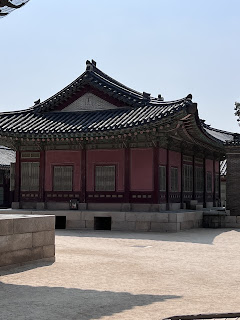 This was part of the well system.
This was part of the well system.
Stone gargoyles sit atop most of the buildings. These are the guardians of the four directions and the 12 Chinese zodiac animal signs.
Even the ceiling was ornate.
This is a famous photo spot located along the edge of the courtyard.
강녕전 Gangnyeongjeon Hall sets on 월대 woldae, or an elevated stone platform. It is the living quarters and resting area of the king and the name means virtue of health. It is said the king also met with his entourage in the building to discuss daily activities, state affairs, and office duties.
A hemispherical sundial, called an 앙부일구 angbuilgu, was invented in 1434. The bronze dial is engraved with seven longitudinal and thirteen latitudinal lines which mark the hours and seasons.The queen had her own set of personal buildings with the main one called 교태전 Gyotaejeon Hall. This building and a few others had 온돌 ondol heating. That is where the hot water runs under the floor. We have that type of heating in our apartment. It was in Gyotaejeon that the queen had her main living quarters and resting area. It served as the location where the queen oversaw the operation of the household at the palace.

Stone gargoyles sit atop most of the buildings. These are the guardians of the four directions and the 12 Chinese zodiac animal signs.
The queen was not allowed to leave the palace premises, so King 태조 Taejo built the garden of 암이산 Amisan for her that contained a terraced flower garden with various plants that bloomed throughout all the seasons.
This building was the birthing center.When constructing the queen's quarters, they laid decorated stonework and four chimneys. These chimneys used ornate terra cotta clay to make the bricks because it was more feminine looking.
The color of these bricks is the reason that the taxis in Seoul are orange.
A cute couple dressed in tradditional 한복 hanbok, walking hand in hand. They are headed to one of the buildings that is thought to possibly be used for concubines and court ladies. Many people had rented hanboks to take photos.
The 'pavilion of far-reaching fragrance,' 향원정 Hyangwonjeong Pavilion, constructed by King 고종Gojong in 1873, was where the king would rest during his leisure time.Here are the students that gave us the tour.
There is a tragic story surrounding 곤넝합 Gonnyeonghap Hall, which was built for King Gojong's wife Queen 명성 Myeongseong. After the Japanese invaded Manchuria, the royal family advocated for stronger ties between Korea and Russia in an attempt to block Japanese influence. This triggered a group of Japanese assassins to raid the queen's residence and kill her.
There was also a library. Reading was very important to King 세종 Sejong because he was the one to introduce hangul to the country.King Taejong constructed an open two-story pavilion called 경회루 Gyeonghoeru Pavilion in 1412, along with the pond surrounding it.
Various events illuminate its history, including royal banquets, reception of foreign envoys, final state examinations, and seasonal rituals, while royalty enjoyed boating on the pond. The pavilion was also destroyed in the late 1500s and restored in the late 1800s. It stands as the largest elevated pavilion in Korea with a floor area of 933 square meters. Three bays at the center symbolize heaven, earth and man, and the 12 bays outside them symbolize the twelve months of the year. The outermost 24 columns represent the 24 solar terms that mark astronomical events of the year. It is still used today for various events, including a concert by the famous boy band BTS.
Look how precious these little punkins are.This is the National Folk Museum of Korea. A few of the inventions housed here are a sundial, rain gauge, water clock, and celestial globes, along with over 4,000 other artifacts.
The main gate has three openings. The king entered through the center, while the crown prince and officials entered through the side gates.
King Sojong sits outside the main gate at Gwanghwamun Square. He is the man who gifted the country with the hangul alphabet, enabling everyone in the country to read and write, and not just the aristocracy.
The king is at the end of the Square, facing the gate and Bugaksan Mountain.이순신 Yi Sunshin, one of the country's other heroes of old, stands guard at the opposite end of the Square.
President Biden was in town the day we were there, scheduled to speak in the same area about an hour afterwards. But we had other plans so we couldn't stick around. The big billboard didn't translate well, but it said something about the war crisis on the Korean Peninsula is escalating, which apparently makes President Biden sad.
We have spotted these goofy statues all over the country, including Busan and Yeosu.
There are several little pagodas like this located haphazardly all around the city.
Daisy and I were witness to a fire breaking out. It looked large, smelled bad, and summoned lots of sirens. But it seemed to get under control relatively quickly and we never heard anything about it.I had my phone out not to take pictures of the fire, but to take pictures of all the tents that people erect in the park, just to spend time outdoors. Most people live in apartments without balconies, so they plop down their tents pretty much anywhere there is grass. This even happens in the little city of Sacheon.
Daisy and I hopped aboard for a Han River sunset cruise.
The 한강 Hangang is the 4th longest river on the Korean peninsula. Two smaller rivers beginning in North Korea feed into it near Seoul. Hundreds of years ago the river was used as a trade route to China.
Sixty-three building is located nearby the dock, so we checked out Seoul from 60 stories above.

Wait, why is it called 63 tower if there are only 60 floors? There are also 3 basement levels. Measuring at 817 feet high, it was the tallest building outside North America when it opened in 1985. Other buildings have since surpassed it in height, but it still proudly boasts being the tallest gold-clad structure in the world. So there's that.
There is a small art display at the top.
Here is a view of the golden building from the outside.
On the way back we wandered through the cute little streets of 인자동 Insadong.How could we not get this dessert when it was personalized just for my Daisy?
Remember when I said we did a lot of walking because sometimes we didn't take the most direct route? This was one of those times. We just happened to stumble upon 조계사 Jogyesa Temple. We visited this temple during our first trip to Seoul on our Segway tour.
All the lanterns from Buddha's birthday a few weeks ago were still up. It was so pretty.

This huge Chinese Scholar tree stands 85 feet high with a circumference of 13 feet. But what's most impressive is that the tree is over 450 years old.
It was beautiful the way the branches poked out of the top of the lantern ceiling.
I was poking fun of my eyes in this picture. Daisy made an off-color joke about me bragging about my big eyes; not exactly PC, but it made us laugh.
This lacebark pine tree is 500 years old.The lanterns created a lotus flower overhead.
At the top of a set of stairs rests the bell tower.
The following day we did even more shopping in search of the elusive prom dress. Sadly enough, we went home empty handed.Our shopping bags were empty, but our hearts were full.💗
[May 20-22]











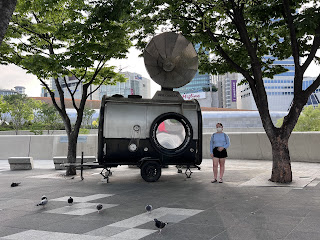





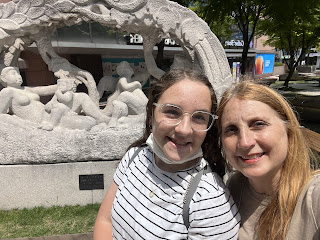







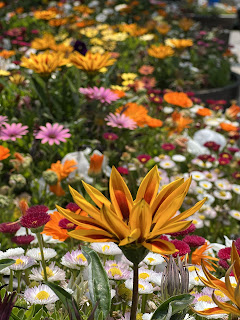






















































































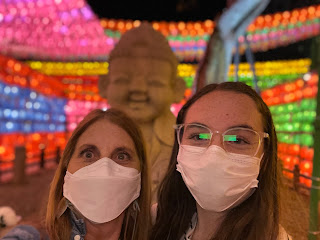














No comments:
Post a Comment